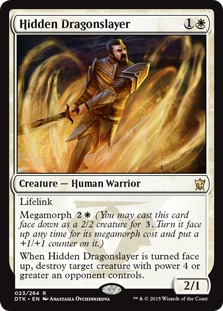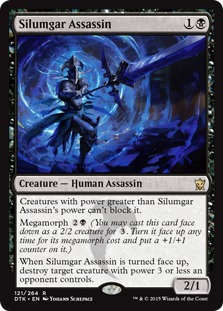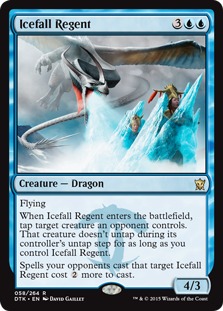The Multiple Rotations of Dragons of Tarkir
Dragons of Tarkir is a unique set in several ways, but I believe one attribute is more important than the others. I'm not talking about the dragon overdose, the much maligned megamorph, or even the way lower than normal box expected value and presale prices. These things are unique, but every Magic set is unique in its flavor, setting, and mechanics. No, what sets DTK apart from every other Magic set is that it will survive not just one, but two different Standard rotations.
First, in September with the release of Battle for Zendikar, all of Theros block will fade from standard and enter the endless abyss of non-rotating formats. This will make Standard the entirety of the Khans of Tarkir block, along with Magic Origins and BFZ. Next spring, about a year from now, the first set in whatever block happens to come after Zendikar (codename: Tears) will release, which will cause Khans of Tarkir and Fate Reforged to rotate, but leave DTK (along with ORI) in Standard for another six months. Finally, in the fall of 2016, a set codenamed Lock will be released which will finally hail the rotation of Dragons of Tarkir.
This is important because rotations have a huge impact on card playability and card value. When Theros and M15 rotate this fall, eight out of the ten most played cards in Standard will be leaving the format and something is going to fill this void. While some of these cards will be from Khans of Tarkir or Fate Reforged (something like Siege Rhino might move from the mid-teens to top 5), there will also be some cards from Dragons of Tarkir that suddenly go from unplayed to "on the list" and jump accordingly in value.
The beauty of Dragons of Tarkir is that it will go through this process twice. As a result, if you buy in low on DTK cards that seem powerful but might not fit in the current Standard meta, you have not one, but two format shake-ups to make these bets pay off. So today, instead of talking about long-term casual buys (which DTK seems to be full of) or the immediate future of the set, we will be discussing some Dragons cards that could be good bets for gains at one of these two rotations.
You might be wondering why I'm writing about this now and not in a few months when DTK will hit peak supply and prices will typically be at their lowest. This is because, again, DTK is not your typical set. Judging by the extremely low EV, at least some DTK cards are likely already at their floor during pre-sales. While the total set price will likely drop, there is an above average chance that this set decreases less than most others (either that or it's a modern day Homelands). Plus, given the low prices, some cards might actually increase despite the influx of supply. Anyway, here are some DTK cards that I think have rotation potential along with some of the reasons why.
Morphs





Initially I wasn't impressed by any of these cards, but I'm starting to think my gut impression was tainted by my dislike of megamorph as a name and mechanic. What I overlooked is that all of these cards are fine, on-curve options on at their normal casting cost. Instead of viewing them as four-, five-, or six-drop 3/2's with somewhat relevant (but overcosted) abilities, they need to be viewed as acceptable two drops who still have relevance when you draw them on turn 6 thanks to their "turned face up" abilities. These cards are not face-down three drops, they are aggressive two drops that range from fine to very good in the late game.
Take Ire Shaman for example. What we have here is a split card: The first half is a somewhat evasive 2/1 for 1R; not exciting but perfectly playable for a mono-red deck looking to curve out. The other half of the card is a somewhat evasive 3/2 for 3 that lets you draw a card for R. This half of the card is probably not quite playable on its own, but it isn't that far away either. In short, Ire Shaman is good on turn two, and fine on turns three or even hellbent on turn seven (where you can play and unmorph all in the same turn). Because of the first half of the card — the 2/1 for 1R — the card will always be good in an aggressive red build. Remember, you're not playing it as a 3- or 7-drop, you're playing it as a two-drop; the late-game abilities are just icing on the cake.
You can go down the list and comes up with similar conclusions. Hidden Dragonslayer isn't that far from being a good two-drop and a Reprisal. Stratus Dancer has the best evasion of the bunch, but is penalized by having the most overcosted ability even if it is technically an uncounterable counter (I mean, Muddle the Mixture has upside and costs UU). Silumgar Assassin and Den Protector are actually quite similar in having very situational evasion and unmorph abilities that normally cost two mana: Smother and Recollect.
It seems likely that the white and red megamorphs are the best in the cycle. Not only are they in the right colors to be in aggressive builds that can take advantage of their printed mana costs, but they each have some amount of upside. We have never seen a card that just says "draw a card" for one red mana, and I'm not sure we ever will. Hidden Dragonslayer is in the right colors for the "warrior" creature type to actually matter.
Of course, all this is dependent on the metagame. All of these cards really want an aggressive or tempo-oriented build, or the development of a true unmorph deck. The latter seems most possible this fall, before the rest of the Khans of Tarkir block rotates. People are coming around to Deathmist Raptor being a powerful card, and if it is really good enough to build a deck around, a dedicated morph deck will likely include at least some of these cards once Green-X Devotion rotates with Theros.
Warriors


People have been trying to make Black-White or Mardu Warriors work for a while now, but thus far the deck has been unable to rise past tier-two status. This could change in the fall for a few reasons: First, many cards that are super problematic for the deck leave the format, most notably Sylvan Caryatid, Courser of Kruphix, Drown in Sorrow, Anger of the Gods and Bile Blight. Second, several of the cards that push aggro players in other directions like Stoke the Flames and Goblin Rabblemaster also rotate. Third, scrylands rotate. While these enter-the-battlefield tapped lands have proven to be much better than the community initially thought, they do tend to favor midrange and control strategies over pure aggro. Given the choice, BW Warrior would rather play Marsh Flats over Temple of Silence every day of the week. Fourth, it is all but guaranteed that Marsh Flats and the rest of the enemy fetchlands will be returning to Standard with Battle for Zendikar. Finally, with the addition of Dragons of Tarkir, the curve of the Warrior deck looks pretty strong.

This is an initial take, so it's rough around the edges. The manabase will likely get better assuming we get a land cycle in Magic Origins. If you are going to actually play it in an event, you'll want to adjust the numbers and play some amount of removal. What exactly these spells should be is unknown considering we still have two more sets to go, but the curve itself looks solid. You get to play one or more above-the-curve spells at every point on the curve and take advantage of some sweet Warrior synergy.
If this deck, or something like it, becomes a real deck in Standard, both of the rare Dragons of Tarkir warriors could be worth a few bucks. This is especially true of Arashin Foremost; it has the pedigree of Silverblade Paladin but with the massive restriction of only working in a tribal Warrior deck. I'm less sure of Blood-Chin Fanatic, but its ability does represent a type of reach that is often missing from non-red aggro decks. I can imagine situations where once you untap with Blood-Chin Fanatic, you can sacrifice a bunch of stonewalled one-drops and just win the game. While it might not look that impressive on its face, it does represent a must-answer threat in the right build.
For all of these cards, buying in is more of a bet on the deck as a whole than on the cards individually. Their window is likely short given that KTK and FRF rotate before DTK. However, given the current price of Blood-Chin Fanatic, Arashin Foremost and the derth of value in the set, it won't take much play this fall for either of these card to triple up to the $3-$4 range.
Dragons


While there are probably good arguments for some of the other dragons from DTK becoming players in Standard, these are the two that seem to have the most potential in the dark. Icefall Regent is an interesting mix of Frost Titan and Dungeon Geists. Both cards were playable and even very good at some points during their time in Standard. For the immediate future, the biggest benefit of the blue dragon is that it locks down all of the other dragons, not to mention all of the other midrange creatures that are so dominant in Standard. Plus, thanks to its Frost Titanesque second ability, your opponent will often have to spend their entire turn to kill with something like a Hero's Downfall.
Looking to the future, it seems likely that Battle for Zendikar will make Icefall Regent even better. Mark Rosewater has stated many times that one of his main jobs is to meet the expectations of players. When it comes to "return to" sets like Battle for Zendikar, Return to Ravnica, and Scars of Mirrodin, there are some things that basically have to be included. For Battle of Zendikar, this includes fetches, lands-matter mechanics, and Eldrazi. Assuming the Eldrazi are still running around Zendikar, Icefall Regent could be an awesome answer to these fatties. How many cards can lock down both Emrakul, the Aeons Torn and Ulamog, the Infinite Gyre while providing a fast, evasive clock? Not many.
Harbinger of the Hunt, on the other hand, provides a very reasonable answer to a bunch of cards that will likely continue to be heavily played post-rotation. For only three mana you can wipe away Hordeling Outburst, Raise the Alarm, Monk tokens from Monastery Mentor, the entire megamorph cycle we talked about earlier, Secure the Wastes, Rattleclaw Mystic, and pretty much the entire mono-red deck. For six mana you can clear out an infinite number of morphs, which is especially important given the popularity of Whisperwood Elemental and Mastery of the Unseen, both of which survive the fall rotation. Plus, some type of Jund/Gruul midrange deck has been present and often tier one in basically every Standard for the past five years, so it should have a home.
Again, the best case scenario is likely a few dollars, and seeing 4-of play is far from guaranteed, but the benefit of buying bulk-level dragons is they all seem good for the long-run from casual demand alone (barring reprintings of course). The allure of the Dragon creature type is just too strong for many casual players to resist.
Mono-Red


Aggro decks thrive during rotation. While it often takes a few weeks for control decks to figure out the right answers, aggro decks always know what they want to be doing: curving out and beating down. Due to the new rotation schedule, Dragon Whisperer and Zurgo Bellstriker get not one, but two rotations while they are Standard legal, which means twice as many chances to shine. This is not to say that mono-red will be a bad deck at other times, but it will typically be even better when the format is in flux.
I have very little doubt that Zurgo Bellstriker will see play. Pretty much every red one-drop with two-power is good enough for Standard. The downside of not being able to chump in the mid-game isn't the worst drawback ever; (Rakdos Cackler couldn't block at all and was widely played. Even though I wish the dash cost one (mostly because it would truly be a bazaaro Goblin Guide — instead of giving your opponent a land, it costs you one), the ability to play it off the top with haste makes it relevant in the late game. My biggest concern is that the new Zurgo is legendary, which could mean it is a three-of rather than a four-of, but I'll leave that question for better deck builders than myself. The ceiling on these types of cards isn't super high, but it's also at least double its current price.
I don't think Dragon Whisperer is a very good card, especially considering that it's a mythic. However, if you look over the list of red two-drops in Standard, the competition isn't that fierce and will be even less so after Theros block rotates. Almost by default, Dragon Whisperer should occupy the two-drop slot in aggressive red lists come autumn, and seeing 4-of play as a third set mythic (especially a DTK mythic, due to potential low supply) can do crazy things to a mythic two-drop. Since most of the other mythics are either high-CMC casual cards, strange megamorphs, or a complete slap in the face, Dragon Whisperer is one of the a few mythics that have a legitimate claim of being the most expensive non-planeswalker card in the set six months to a year from now.
Living Lore
I keep feeling like I'm missing something here. In a deck with Satyr Wayfinder, Commune with the Gods, Dig Through Time, and Treasure Cruise, Living Lore is consistently, with very little work, an 8/8 on turn four. With upside. In blue. Maybe an 8/8 for four just isn't good enough these days? Most people I've asked seem to think that a 6/6 or 7/7 for four should see play, but others pointed out that a couple years ago LSV said he wouldn't play a vanilla 20/20 for five.
Maro, in his most recent article, revealed that Living Lore was basically a card he had designed for an "Un-set" that was never released. This seems like the kind of card that people will at least try to put to good use in Standard (e.g. Chromanticore, Soulflayer). Of course Living Lore seeing play isn't a sure thing, but it still surprises me that most people think a 7/7 for four-mana is a good, but no one is talking about the potential 8/8 for four-mana in Living Lore.
Conclusion
Anyway, that's all for today. Any guesses on how surviving not one, but two rotations will impact the prices of Dragons of Tarkir cards? What cards do you think will get better post-rotation? Maybe most importantly, given the low set EV, do you think any of these cards are already at their floor, or will increasing supply drop them even further despite the set's low EV? As always, let me know in the comments, or on Twitter @SaffronOlive.













